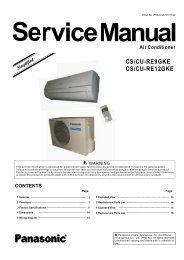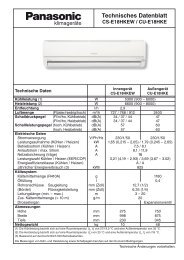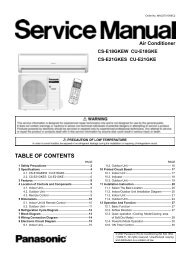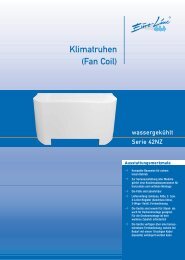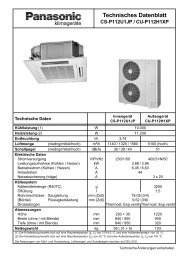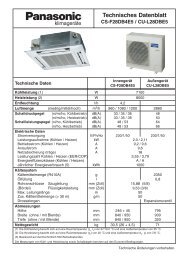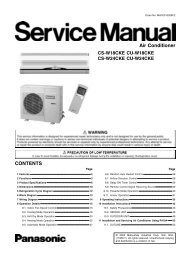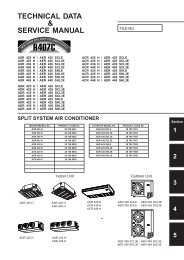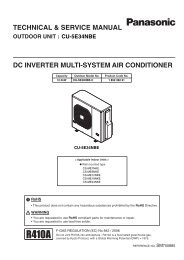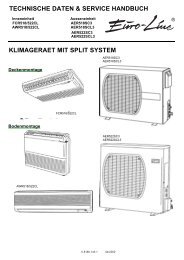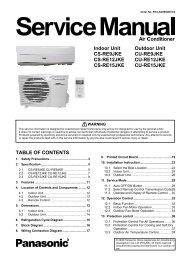technical & service manual split system air conditioner
technical & service manual split system air conditioner
technical & service manual split system air conditioner
Create successful ePaper yourself
Turn your PDF publications into a flip-book with our unique Google optimized e-Paper software.
TECHNICAL & SERVICE MANUAL<br />
AWR222CLE - AER222SC<br />
AWR222CLE - AER222SC3<br />
SPLIT SYSTEM AIR CONDITIONER<br />
0.8180.076.0 03/00
Important!<br />
Please Read Before Starting<br />
This <strong>air</strong> conditioning <strong>system</strong> meets strict safety and<br />
operating standards. As the installer or <strong>service</strong> person,<br />
it is an important part of your job to install or <strong>service</strong> the<br />
<strong>system</strong> so it operates safely and efficiently.<br />
For safe installation and trouble-free operation, you<br />
must:<br />
●Carefully read this instruction booklet before<br />
beginning.<br />
●Follow each installation or rep<strong>air</strong> step exactly as<br />
shown.<br />
●Observe all local, state, and national electrical codes.<br />
●Pay close attention to all warning and caution notices<br />
given in this <strong>manual</strong>.<br />
This symbol refers to a hazard or<br />
WARNING unsafe practice which can result<br />
in severe personal injury or<br />
death.<br />
This symbol refers to a hazard or<br />
CAUTION unsafe practice which can result<br />
in personal injury or product or<br />
property damage.<br />
If Necessary, Get Help<br />
These instructions are all you need for most installation<br />
sites and maintenance conditions. If you require help<br />
for a special problem, contact our sales/<strong>service</strong> outlet<br />
or your certified dealer for additional instructions.<br />
In Case of Improper Installation<br />
The manufacturer shall in no way be responsible for<br />
improper installation or maintenance <strong>service</strong>, including<br />
failure to follow the instructions in this document.<br />
Special Precautions<br />
WARNING<br />
When Wiring<br />
ELECTRICAL SHOCK CAN CAUSE<br />
SEVERE PERSONAL INJURY OR<br />
DEATH. ONLY A QUALIFIED,<br />
EXPERIENCED ELECTRICIAN SHOULD<br />
ATTEMPT TO WIRE THIS SYSTEM.<br />
• Do not supply power to the unit until all wiring and<br />
tubing are completed or reconnected and checked.<br />
• Highly dangerous electrical voltages are used in this<br />
<strong>system</strong>. Carefully refer to the wiring diagram and<br />
these instructions when wiring. Improper connections<br />
and inadequate grounding can cause accidental<br />
injury or death.<br />
• Ground the unit following local electrical codes.<br />
• Connect all wiring tightly. Loose wiring may cause<br />
overheating at connection points and a possible fire<br />
hazard.<br />
i<br />
When Transporting<br />
Be careful when picking up and moving the indoor and<br />
outdoor units. Get a partner to help, and bend your<br />
knees when lifting to reduce strain on your back. Sharp<br />
edges or thin aluminum fins on the <strong>air</strong> <strong>conditioner</strong> can<br />
cut your fingers.<br />
When Installing…<br />
…In a Ceiling or Wall<br />
Make sure the ceiling/wall is strong enough to hold the<br />
units weight. It may be necessary to construct a strong<br />
wood or metal frame to provide added support.<br />
…In a Room<br />
Properly insulate any tubing run inside a room to<br />
prevent “sweating” that can cause dripping and water<br />
damage to walls and floors.<br />
…In Moist or Uneven Locations<br />
Use a raised concrete pad or concrete blocks to<br />
provide a solid, level foundation for the outdoor unit.<br />
This prevents water damage and abnormal vibration.<br />
…In an Area with High Winds<br />
Securely anchor the outdoor unit down with bolts and a<br />
metal frame. Provide a suitable <strong>air</strong> baffle.<br />
…In a Snowy Area (for Heat Pump-type Systems)<br />
Install the outdoor unit on a raised platform that is<br />
higher than drifting snow. Provide snow vents.<br />
When Connecting Refrigerant Tubing<br />
• Use the flare method for connecting tubing.<br />
• Apply refrigerant lubricant to the matching surfaces<br />
of the flare and union tubes before connecting them,<br />
then tighten the nut with a torque wrench for a leakfree<br />
connection.<br />
• Check carefully for leaks before starting the test run.<br />
When Servicing<br />
• Turn the power off at the main power box (mains)<br />
before opening the unit to check or rep<strong>air</strong> electrical<br />
parts and wiring.<br />
• Keep your fingers and clothing away from any<br />
moving parts.<br />
• Clean up the site after you finish, remembering to<br />
check that no metal scraps or bits of wiring have<br />
been left inside the unit being <strong>service</strong>d.<br />
Others<br />
CAUTION<br />
• Ventilate any enclosed areas when installing or<br />
testing the refrigeration <strong>system</strong>. Escaped refrigerant<br />
gas, on contact with fire or heat, can produce<br />
dangerously toxic gas.<br />
• Confirm upon completing installation that no<br />
refrigerant gas is leaking. If escaped gas comes in<br />
contact with a stove, gas water heater, electric room<br />
heater or other heat source, it can produce<br />
dangerously toxic gas.
Table of Contents<br />
Page<br />
1. OPERATING RANGE .............................................................................................................................. 1<br />
2. SPECIFICATIONS<br />
2-1. Unit Specifications.......................................................................................................................... 2<br />
2-2. Major Component Specifications.................................................................................................... 4<br />
2-3. Other Component Specifications.................................................................................................... 7<br />
3. DIMENSIONAL DATA.............................................................................................................................. 8<br />
4. REFRIGERANT FLOW DIAGRAM ......................................................................................................... 10<br />
5. PERFORMANCE DATA<br />
5-1. Performance charts ....................................................................................................................... 11<br />
5-2. Air Throw Distance Chart .............................................................................................................. 13<br />
5-3. Cooling Capacity ........................................................................................................................... 14<br />
6. ELECTRICAL DATA<br />
6-1. Electrical Characteristics ................................................................................................................ 16<br />
6-2. Electric Wiring Diagrams ................................................................................................................ 17<br />
7. FUNCTION<br />
7-1. Room Temperature Control ........................................................................................................... 20<br />
7-2. Freeze Prevention ......................................................................................................................... 21<br />
7-3. Outdoor Fan Speed Control .......................................................................................................... 22<br />
8. TROUBLESHOOTING<br />
8-1. Check before and after troubleshooting ........................................................................................ 23<br />
8-2. Air <strong>conditioner</strong> does not operate .................................................................................................... 24<br />
8-3. Some part of <strong>air</strong> <strong>conditioner</strong> does not operate .............................................................................. 30<br />
8-4. Air <strong>conditioner</strong> operates, but abnormalities are observed ............................................................. 32<br />
8-5. If a sensor is defective ................................................................................................................... 33<br />
9. REFRIGERANT R407C: SPECIAL PRECAUTIONS WHEN SERVICING THE UNIT<br />
9-1. Characteristics of new refrigerant R407C....................................................................................... 34<br />
9-2. Checklist before serving ................................................................................................................. 34<br />
9-3. Tools specifically for R407C........................................................................................................... 35<br />
9-4. For tubing installation procedures .................................................................................................. 35<br />
9-5. In case of compressor malfunction................................................................................................. 36<br />
9-6. In case refrigerant is leaking........................................................................................................... 38<br />
9-7. Charging additional refrigerant ....................................................................................................... 40<br />
9-8. Retro-fitting existing <strong>system</strong>s.......................................................................................................... 40<br />
11. CHECKING ELECTRICAL COMPONENTS<br />
11-1. Measurement of Insulation Resistance .......................................................................................... 45<br />
11-2. Checking Continuity of Fuse on PCB Ass'y.................................................................................... 46<br />
11-3. Checking Motor Capacitor ............................................................................................................. 46<br />
APPENDIX<br />
INSTRUCTION MANUAL ........................................................................................................ 47<br />
ii
1. OPERATING RANGE<br />
Cooling<br />
Temperature Indoor Air Intake Temp. Outdoor Air Intake Temp.<br />
Maximum 32°C D.B. / 23°C W.B. 43°C D.B.<br />
Minimum 19°C D.B. / 14°C W.B. 19°C D.B.<br />
1
2. SPECIFICATIONS<br />
2-1. Unit Specifications<br />
Indoor Unit AWR222CLE<br />
Outdoor Unit AER222SC<br />
Power Source 220 – 240 V ~ 50 Hz<br />
Cooling<br />
Capacity<br />
kW<br />
BTU/h<br />
6.35 / 6.40 / 6.40<br />
21,669 / 21,837 / 21,840<br />
Air circulation (High) m 3 /h 900<br />
Moisture removal (High) Liters/h 3.3<br />
Voltage rating V 220 / 230 / 240<br />
Available voltage range V 198 to 264<br />
Running amperes A 13.1 / 13.0 / 13.0<br />
Power input W 2,850 / 2,900 / 2,950<br />
Power factor % 99 / 97 / 95<br />
C.O.P. W/W 2.2 / 2.2 / 2.2<br />
Compressor locked rotor amperes A 67 / 70 / 73<br />
Controls / Temperature control Microprocessor / I.C. thermostat<br />
Control unit Wireless remote control unit<br />
Timer ON/OFF 24-hours & Daily Program<br />
Fan speeds Indoor / Outdoor 3 and Auto / 2 (Auto)<br />
Airflow direction (Indoor )<br />
Horizontal<br />
Vertical<br />
Manual<br />
Auto<br />
Air filter Washable, Anti-Mold<br />
Compressor Rotary (Hermetic)<br />
Refrigerant / Amount charged at shipment g R407C / 2,620<br />
Refrigerant control Capillary tube<br />
Operation sound<br />
Indoor – Hi / Me / Lo<br />
Outdoor – Hi<br />
dB-A<br />
dB-A<br />
47 / 44 / 40<br />
55<br />
Refrigerant tubing connections Flare type<br />
Max. allowable tubing length at shipment m 10<br />
Refrigerant tube Narrow tube mm (in.) 6.35 (1/4)<br />
diameter Wide tube mm (in.) 15.88 (5/8)<br />
Refrigerant tube kit / Accessories Optional / Hanging wall bracket<br />
Indoor Unit Outdoor Unit<br />
Unit dimensions Height mm 360 835<br />
Width mm 1,000 850<br />
Depth mm 205 305<br />
Package dimensions Height mm 282 913<br />
Width mm 1,080 1,000<br />
Depth mm 443 400<br />
Weight Net kg 13.5 67.0<br />
Shipping kg 17.7 76.0<br />
Shipping volume m 3<br />
0.13 0.37<br />
Dimensions & Weight Features Electrical Rating Performance<br />
Remarks: Rating conditions are:<br />
Indoor <strong>air</strong> temperature 27°C DB/19°C WB<br />
Outdoor <strong>air</strong> temperature 35°C DB/24°C WB<br />
2<br />
DATA SUBJECT TO CHANGE WITHOUT NOTICE.
Indoor Unit AWR222CLE<br />
Outdoor Unit AER222SC3<br />
Power Source 380 – 400 V – 3N ~ 50 Hz<br />
Control Circuit 220 – 240 V ~ 50 Hz<br />
Cooling<br />
Capacity<br />
kW<br />
BTU/h<br />
6.25<br />
21,325<br />
Air circulation (High) m 3 /h 900<br />
Moisture removal (High) Liters/h 3.3<br />
Voltage rating V 380 / 400<br />
Available voltage range V 342 to 440<br />
Running amperes A 4.5<br />
Power input W 2,750<br />
Power factor % —<br />
C.O.P. W/W 2.3<br />
Compressor locked rotor amperes A 28<br />
Controls / Temperature control Microprocessor / I.C. thermostat<br />
Control unit Wireless remote control unit<br />
Timer ON/OFF 24-hours & Daily Program<br />
Fan speeds Indoor / Outdoor 3 and Auto / 2 (Auto)<br />
Airflow direction (Indoor )<br />
Horizontal<br />
Vertical<br />
Manual<br />
Auto<br />
Air filter Washable, Anti-Mold<br />
Compressor Rotary (Hermetic)<br />
Refrigerant / Amount charged at shipment g R407C / 2,510<br />
Refrigerant control Capillary tube<br />
Operation sound<br />
Indoor – Hi / Me / Lo<br />
Outdoor – Hi<br />
dB-A<br />
dB-A<br />
48 / 45 / 41<br />
55<br />
Refrigerant tubing connections Flare type<br />
Max. allowable tubing length at shipment m 10<br />
Refrigerant tube Narrow tube mm (in.) 6.35 (1/4)<br />
diameter Wide tube mm (in.) 15.88 (5/8)<br />
Refrigerant tube kit / Accessories Optional / Hanging wall bracket<br />
Indoor Unit Outdoor Unit<br />
Unit dimensions Height mm 360 835<br />
Width mm 1,000 850<br />
Depth mm 205 305<br />
Package dimensions Height mm 282 913<br />
Width mm 1,080 1,000<br />
Depth mm 443 400<br />
Weight Net kg 13.5 67.0<br />
Shipping kg 17.7 76.0<br />
Shipping volume m 3<br />
0.13 0.37<br />
Dimensions & Weight Features Electrical Rating Performance<br />
Remarks: Rating conditions are:<br />
Indoor <strong>air</strong> temperature 27°C DB/19°C WB<br />
Outdoor <strong>air</strong> temperature 35°C DB/24°C WB<br />
3<br />
DATA SUBJECT TO CHANGE WITHOUT NOTICE.
2-1. Major Component Specifications<br />
2-2-1. Indoor Unit<br />
Indoor Unit AWR222CLE<br />
Source 220 – 240 V ~ 50 Hz<br />
Part No. POW-K185GS-N<br />
Controls Microprocessor<br />
Control circuit fuse 250 V – 3 A<br />
Remote Control Unit RCS - 2S1<br />
Q´ty Cross - flow<br />
Number ... Dia. and length mm 1 ... ø100 / L760<br />
Fan motor model ... Q´ty UF2T-31A5P-S ... 1<br />
No. of poles ... rpm (220 / 230 / 240 V, High) 2 ... 1,750 / 1,820 / 1,880<br />
Nominal output W 30<br />
Coil resistance (Ambient temp. 20°C) Ω WHT – BRN : 145.3<br />
WHT – VLT : 53.6<br />
VLT – YEL : 30.9<br />
Safety<br />
devices<br />
Type<br />
Operating temp.<br />
Open<br />
Close<br />
°C<br />
YEL – PNK : 109.2<br />
Internal type<br />
130 ± 8<br />
Automatic reclosing<br />
Run capacitor<br />
µF<br />
VAC<br />
1.8<br />
440<br />
Model M2LJ24ZE31<br />
Rating AC 230 V, 50 Hz<br />
No. of poles ... rpm 8 ... 2.5<br />
Nominal output W 3<br />
Coil resistance (Ambient temp. 20°C) kΩ 16.45 ± 15%<br />
Coil Aluminum plate fin / Copper tube<br />
Rows 2<br />
Fin pitch mm 1.8<br />
Face area m 2<br />
0.192<br />
Controller<br />
PCB<br />
Louver Motor Fan & Fan Motor<br />
Heat<br />
Exch. Coil<br />
4<br />
DATA SUBJECT TO CHANGE WITHOUT NOTICE.
2-2-2. Outdoor Unit<br />
Outdoor Unit AER222SC<br />
Compressor<br />
Type Rotary (Hermetic)<br />
Compressor model C-RN221H5A 80244035<br />
Source 220 – 240 V ~ 50 Hz<br />
Nominal output W 2,200<br />
Compressor oil ... Amount cc FV68S ... 1,350<br />
Coil resistance (Ambient temp. 25°C) Ω C – R : 0.777<br />
C – S : 2.408<br />
Type Internal protector External protector (OLR)<br />
Safety<br />
devices<br />
Overload relay<br />
Operating temp.<br />
Open<br />
Close<br />
°C<br />
°C<br />
—<br />
Automatic opening<br />
Automatic reclosing<br />
OL-D24<br />
150 ± 5<br />
63 ± 10<br />
Operating amp.(Ambient temp. 25°C) — Trip in 6 to 16 sec. at 59A<br />
Run capacitor<br />
µF<br />
VAC<br />
40.0<br />
400<br />
Crank case heater 240V 30W<br />
Type Propeller<br />
Q´ty ... Dia. mm 1 ... ø460<br />
Fan motor model ... Q´ty KFC6S-51B5P ... 1<br />
Source 220 – 240 V ~ 50 Hz<br />
No. of poles ... rpm (220 V, High) 6 ... 860<br />
Nominal output W 50<br />
Coil resistance (Ambient temp. 20°C) Ω WHT – BRN : 95.9<br />
WHT – YEL : 55.4<br />
YEL – PNK : 7.2<br />
Safety<br />
devices<br />
Type<br />
Operating temp.<br />
Open<br />
Close<br />
°C<br />
Internal type<br />
130 ± 8<br />
Automatic reclosing<br />
Run capacitor<br />
µF<br />
VAC<br />
5.0<br />
440<br />
Coil Aluminum plate fin / Copper tube<br />
Rows 2<br />
Fin pitch mm 1.9<br />
Face area m 2<br />
0.610<br />
External Finish Acrylic baked-on enamel finish<br />
Fan & Fan Motor<br />
Heat<br />
Exch. Coil<br />
5<br />
DATA SUBJECT TO CHANGE WITHOUT NOTICE.
Outdoor Unit AER222SC3<br />
Power source 380 – 400 V – 3N ~ 50 Hz<br />
Control circuit 220 – 240 V ~ 50 Hz<br />
Type Rotary (Hermetic)<br />
Compressor model C-RN223H8A 80244088<br />
Source 380 – 400 V – 3N ~ 50 Hz<br />
Nominal output W 2,200<br />
Compressor oil ... Amount cc FV68S ... 1,350<br />
Coil resistance (Ambient temp. 25°C) Ω C – R : 4.97<br />
C – S : 4.64<br />
R – S : 4.88<br />
Type Internal protector External protector<br />
Safety<br />
devices<br />
Overload relay<br />
Operating temp.<br />
Open<br />
Close<br />
°C<br />
°C<br />
—<br />
Automatic opening<br />
Automatic reclosing<br />
HOE-10TB TH-7A<br />
—<br />
—<br />
Operating amp.(Ambient temp. 25°C) — 7A<br />
Run capacitor<br />
µF<br />
VAC<br />
—<br />
—<br />
Crank case heater 240V 30W<br />
Type Propeller<br />
Q´ty ... Dia. mm 1 ... ø460<br />
Fan motor model ... Q´ty KFC6S-51B5P ... 1<br />
Source 220 – 230 V ~ 50 Hz<br />
No. of poles ... rpm (220 V, High) 6 ... 840<br />
Nominal output W 50<br />
Coil resistance (Ambient temp. 20°C) Ω WHT – BRN : 95.9<br />
WHT – PNK : 55.4<br />
YEL – PNK : 7.2<br />
Safety<br />
devices<br />
Type<br />
Operating temp.<br />
Open<br />
Close<br />
°C<br />
Internal type<br />
130 ± 8<br />
Automatic reclosing<br />
Run capacitor<br />
µF<br />
VAC<br />
5.0<br />
440<br />
Coil Aluminum plate fin / Copper tube<br />
Rows 2<br />
Fin pitch mm 1.9<br />
Face area m 2<br />
0.610<br />
External Finish Acrylic baked-on enamel finish<br />
Compressor<br />
Fan & Fan Motor<br />
Heat<br />
Exch. Coil<br />
6<br />
DATA SUBJECT TO CHANGE WITHOUT NOTICE.
3. DIMENSIONAL DATA<br />
Indoor Unit AWR222CLE<br />
49<br />
64<br />
Center of tubing hole<br />
(for right rear)<br />
1000<br />
8<br />
74<br />
360<br />
Rear panel (center point of gravity)<br />
61<br />
Drain hose ø26<br />
Narrow tube ø6.35 (1/4")<br />
Wide tube ø15.88 (5/8")<br />
205<br />
Remote control unit<br />
61<br />
172.5<br />
18.5<br />
Unit : mm
Outdoor Unit AER222SC<br />
AER222SC3<br />
560<br />
130 620<br />
100 55<br />
250<br />
Air intake<br />
Air discharge<br />
850<br />
250<br />
20<br />
20<br />
6 – ø3.1 holes<br />
325<br />
835<br />
9<br />
57<br />
229<br />
Wide tube <strong>service</strong> valve ø15.88 (5/8")<br />
Narrow tube <strong>service</strong> valve ø6.35 (1/4")<br />
Check port ø6.35 (1/4")<br />
285<br />
86<br />
88<br />
155<br />
73<br />
86<br />
Unit : mm
4. REFRIGERANT FLOW DIAGRAM<br />
Indoor Unit AWR222CLE Outdoor Unit AER222SC<br />
AER222SC3<br />
Indoor Unit Outdoor Unit<br />
Muffler<br />
Evaporator<br />
Wide tube<br />
O.D.<br />
ø15.88 mm<br />
(5/8 ")<br />
Narrow tube<br />
O.D.<br />
ø6.35 mm<br />
(1/4")<br />
Insulation of Refrigerant Tubing<br />
IMPORTANT<br />
Wide tube<br />
<strong>service</strong><br />
valve<br />
Narrow<br />
tube<br />
<strong>service</strong><br />
valve<br />
Check port<br />
Capillary tube<br />
10<br />
Muffler<br />
Because capillary tubing is used in the outdoor unit, both the<br />
wide and narrow tubes of this <strong>air</strong> <strong>conditioner</strong> become cold. To<br />
prevent heat loss and wet floors due to dripping of<br />
condensation, both tubes must be well insulated with a proper<br />
insulation material. The thickness of the insulation should be a<br />
min. 8 mm.<br />
CAUTION<br />
After a tube has been insulated,<br />
never try to bend it into a narrow<br />
curve because it can cause the tube<br />
to break or crack.<br />
Accumulator<br />
Capillary for<br />
liquid injection<br />
Thickness:<br />
Min. 8 mm<br />
Wide tube<br />
Drier<br />
Condenser<br />
Compressor<br />
Insulation<br />
Narrow tube<br />
Thickness:<br />
Min. 8 mm
5. PERFORMANCE DATA<br />
5-1. Performance charts<br />
Indoor Unit AWR222CLE<br />
Outdoor Unit AER222SC<br />
NOTE<br />
Low pressure at wide tube <strong>service</strong> valve MPa (kgf/cm 2G)<br />
■ Cooling Characteristics<br />
Operating current (A)<br />
17<br />
16<br />
15<br />
14<br />
13<br />
12<br />
11<br />
10<br />
9<br />
1.1 (10)<br />
1.0 ( 9 )<br />
0.9 ( 8 )<br />
0.8 ( 7 )<br />
0.7 ( 6 )<br />
0.6 ( 5 )<br />
0.5 ( 4 )<br />
0.4 ( 3 )<br />
0.3 ( 2 )<br />
0.2 ( 1 )<br />
0.1 ( 0 )<br />
Indoor inlet <strong>air</strong><br />
D.B. temp. (°C)<br />
Outdoor<br />
fan speed<br />
Low<br />
High<br />
8<br />
25 30 35 40 45 50<br />
Outdoor inlet <strong>air</strong> D.B. temp. (°C)<br />
Indoor inlet <strong>air</strong><br />
D.B. temp. (°C)<br />
Outdoor<br />
fan speed<br />
Low<br />
High<br />
25 30 35 40 45 50<br />
Outdoor inlet <strong>air</strong> D.B. temp. (°C)<br />
● ...... Points of Rating condition<br />
Black dots in above charts indicate the following rating conditions.<br />
Cooling: Indoor <strong>air</strong> temperature 27°C D.B./19°C W.B.<br />
Outdoor <strong>air</strong> temperature 35°C D.B./24°C W.B.<br />
11<br />
32<br />
27<br />
21<br />
32<br />
27<br />
21
Indoor Unit AWR222CLE<br />
Outdoor Unit AER222SC3<br />
NOTE<br />
Low pressure at wide tube <strong>service</strong> valve MPa (kgf/cm 2G)<br />
■ Cooling Characteristics<br />
Operating current (A)<br />
10<br />
9<br />
8<br />
7<br />
6<br />
5<br />
4<br />
3<br />
2<br />
1.1 (10)<br />
1.0 ( 9 )<br />
0.9 ( 8 )<br />
0.8 ( 7 )<br />
0.7 ( 6 )<br />
0.6 ( 5 )<br />
0.5 ( 4 )<br />
0.4 ( 3 )<br />
0.3 ( 2 )<br />
0.2 ( 1 )<br />
0.1 ( 0 )<br />
Indoor inlet <strong>air</strong><br />
D.B. temp. (°C)<br />
Outdoor<br />
fan speed<br />
Low<br />
High<br />
1<br />
25 30 35 40 45 50<br />
Outdoor inlet <strong>air</strong> D.B. temp. (°C)<br />
Indoor inlet <strong>air</strong><br />
D.B. temp. (°C)<br />
Outdoor<br />
fan speed<br />
Low<br />
High<br />
25 30 35 40 45 50<br />
Outdoor inlet <strong>air</strong> D.B. temp. (°C)<br />
● ...... Points of Rating condition<br />
Black dots in above charts indicate the following rating conditions.<br />
Cooling: Indoor <strong>air</strong> temperature 27°C D.B./19°C W.B.<br />
Outdoor <strong>air</strong> temperature 35°C D.B./24°C W.B.<br />
12<br />
32<br />
27<br />
21<br />
32<br />
27<br />
21
5-2. Air Throw Distance Chart<br />
Indoor Unit AWR222CLE<br />
Fan speed : High<br />
Axis <strong>air</strong> verocity (m/s)<br />
Vertical distance (m)<br />
0<br />
1<br />
2<br />
3<br />
4<br />
1 2 3 4 5 6 7 8 9<br />
Axis <strong>air</strong> verocity<br />
0°<br />
Flap angle<br />
30°<br />
13<br />
Horizontal distance (m)
5-3. Cooling Capacity<br />
Indoor Unit AWR222CLE<br />
Outdoor Unit AER222SC<br />
240V Single Phase 50Hz<br />
RATING CAPACITY 6.40 kW<br />
AIR FLOW RATE 900 m 3 /h<br />
EVAPORATOR CONDENSER<br />
ENT. TEMP. °C OUTDOOR AMBIENT TEMP. °C<br />
W.B. D.B. 30 35 40 45<br />
TC 5.89 5.61 5.27 4.85<br />
CM 2.40 2.57 2.76 2.97<br />
21 SHC 3.87 3.72 3.54 3.32<br />
15 23 SHC 4.29 4.14 3.96 3.74<br />
25 SHC 4.72 4.56 4.38 4.17<br />
27 SHC 5.14 4.99 4.81 4.59<br />
29 SHC 5.56 5.41 5.23 4.85<br />
31 SHC 5.89 5.61 5.27 4.85<br />
TC 6.32 6.02 5.66 5.20<br />
CM 2.47 2.65 2.84 3.05<br />
21 SHC 3.44 3.28 3.10 2.88<br />
17 23 SHC 3.86 3.71 3.53 3.31<br />
25 SHC 4.29 4.13 3.95 3.73<br />
27 SHC 4.71 4.55 4.37 4.15<br />
29 SHC 5.13 4.98 4.80 4.58<br />
31 SHC 5.56 5.40 5.22 5.00<br />
TC 6.72 # 6.40 6.02 5.54<br />
CM 2.54 2.73 2.92 3.14<br />
21 SHC 2.98 2.82 2.64 2.43<br />
19 23 SHC 3.40 3.25 3.07 2.85<br />
25 SHC 3.82 3.67 3.49 3.27<br />
27 SHC 4.25 4.09 3.92 3.70<br />
29 SHC 4.67 4.52 4.34 4.12<br />
31 SHC 5.09 4.94 4.76 4.54<br />
TC 7.12 6.78 6.38 5.87<br />
CM 2.61 2.80 3.00 3.22<br />
23 SHC 2.93 2.78 2.60 2.39<br />
21 25 SHC 3.35 3.20 3.03 2.81<br />
27 SHC 3.78 3.63 3.45 3.23<br />
29 SHC 4.20 4.05 3.87 3.66<br />
31 SHC 4.62 4.47 4.30 4.08<br />
TC 7.55 7.12 6.67 6.20<br />
CM 2.68 2.88 3.08 3.31<br />
23 25 SHC 2.85 2.68 2.49 2.31<br />
27 SHC 3.27 3.10 2.92 2.74<br />
29 SHC 3.70 3.52 3.34 3.16<br />
31 SHC 4.12 3.95 3.76 3.58<br />
TC : Total Cooling Capacity (kW)<br />
SHC : Sensible Heat Capacity (kW)<br />
CM : Compressor Input (kW)<br />
Rating conditions (#Mark) are<br />
Outdoor Ambient Temp. 35°C D.B.<br />
Indoor Unit Entering Air Temp. 27°C D.B. / 19°C W.B.<br />
14
Indoor Unit AWR222CLE<br />
Outdoor Unit AER222SC3<br />
240V Single Phase 50Hz<br />
RATING CAPACITY 6.25 kW<br />
AIR FLOW RATE 900 m 3 /h<br />
EVAPORATOR CONDENSER<br />
ENT. TEMP. °C OUTDOOR AMBIENT TEMP. °C<br />
W.B. D.B. 30 35 40 45<br />
TC 5.75 5.48 5.14 4.74<br />
CM 2.25 2.41 2.63 2.92<br />
21 SHC 3.80 3.65 3.48 3.27<br />
15 23 SHC 4.22 4.08 3.90 3.69<br />
25 SHC 4.65 4.50 4.32 4.11<br />
27 SHC 5.07 4.92 4.75 4.54<br />
29 SHC 5.49 5.35 5.14 4.74<br />
31 SHC 5.75 5.48 5.14 4.74<br />
TC 6.17 5.88 5.52 5.08<br />
CM 2.31 2.48 2.70 2.99<br />
21 SHC 3.37 3.22 3.04 2.83<br />
17 23 SHC 3.79 3.64 3.47 3.26<br />
25 SHC 4.22 4.07 3.89 3.68<br />
27 SHC 4.64 4.49 4.32 4.10<br />
29 SHC 5.06 4.91 4.74 4.53<br />
31 SHC 5.49 5.34 5.16 4.95<br />
TC 6.56 # 6.25 5.88 5.41<br />
CM 2.38 2.56 2.79 3.08<br />
21 SHC 2.91 2.76 2.59 2.38<br />
19 23 SHC 3.33 3.18 3.01 2.80<br />
25 SHC 3.75 3.61 3.43 3.22<br />
27 SHC 4.18 4.03 3.86 3.65<br />
29 SHC 4.60 4.45 4.28 4.07<br />
31 SHC 5.03 4.88 4.70 4.49<br />
TC 6.96 6.63 6.23 5.73<br />
CM 2.45 2.63 2.86 3.16<br />
23 SHC 2.86 2.72 2.55 2.34<br />
21 25 SHC 3.29 3.14 2.97 2.76<br />
27 SHC 3.71 3.56 3.39 3.19<br />
29 SHC 4.13 3.99 3.82 3.61<br />
31 SHC 4.56 4.41 4.24 4.03<br />
TC 7.37 6.96 6.51 6.06<br />
CM 2.51 2.70 2.94 3.24<br />
23 25 SHC 2.78 2.62 2.44 2.27<br />
27 SHC 3.21 3.04 2.86 2.69<br />
29 SHC 3.63 3.46 3.29 3.11<br />
31 SHC 4.05 3.89 3.71 3.54<br />
TC : Total Cooling Capacity (kW)<br />
SHC : Sensible Heat Capacity (kW)<br />
CM : Compressor Input (kW)<br />
Rating conditions (#Mark) are<br />
Outdoor Ambient Temp. 35°C D.B.<br />
Indoor Unit Entering Air Temp. 27°C D.B. / 19°C W.B.<br />
15
6. ELECTRICAL DATA<br />
6-1. Electrical Characteristics<br />
Indoor Unit AWR222CLE<br />
Outdoor Unit AER222SC<br />
Indoor Unit AWR222CLE<br />
Outdoor Unit AER222SC3<br />
Indoor Unit Outdoor Unit Complete Unit<br />
Fan Motor Fan Motor Compressor<br />
Performance at 220V Single phase 50Hz 380V Three phase 50Hz<br />
Rating Conditions Running Amps. A 0.35 0.54 4.21 4.5<br />
Power Input kW 0.077 0.116 2.557 2.75<br />
Full Load Conditions Running Amps. A 0.35 0.54 5.31 5.6<br />
Power Input kW 0.077 0.116 3.237 3.43<br />
Rating Conditions : Indoor Air Temperature 27°C D.B. / 19°C W.B.<br />
Outdoor Air Temperature 35°C D.B.<br />
Full Load Conditions : Indoor Air Temperature 32°C D.B. / 23°C W.B.<br />
Outdoor Air Temperature 43°C D.B.<br />
Indoor Unit Outdoor Unit Complete Unit<br />
Fan Motor Fan Motor Compressor<br />
Performance at 220 / 240V Single phase 50Hz<br />
Rating Conditions Running Amps. A 0.35 / 0.37 0.54 / 0.55 12.21 / 12.08 13.1 / 13.0<br />
Power Input kW 0.077 / 0.089 0.116 / 0.134 2.657 / 2.727 2.85 / 2.95<br />
Full Load Conditions Running Amps. A 0.35 / 0.37 0.54 / 0.55 15.21 / 15.18 16.1 / 16.1<br />
Power Input kW 0.077 / 0.089 0.116 / 0.134 3.307 / 3.307 3.50 / 3.53<br />
Rating Conditions : Indoor Air Temperature 27°C D.B. / 19°C W.B.<br />
Outdoor Air Temperature 35°C D.B.<br />
Full Load Conditions : Indoor Air Temperature 32°C D.B. / 23°C W.B.<br />
Outdoor Air Temperature 43°C D.B.<br />
16
6-2. Electric Wiring Diagrams<br />
Indoor Unit AWR222CLE<br />
17<br />
WARNING<br />
To avoid electrical shock hazard, be sure to<br />
disconnect power before checking, servicing<br />
and/or cleaning any electrical parts.
Outdoor Unit AER222SC<br />
18<br />
WARNING<br />
To avoid electrical shock hazard, be sure to<br />
disconnect power before checking, servicing<br />
and/or cleaning any electrical parts.
Outdoor Unit AER222SC3<br />
19<br />
WARNING<br />
To avoid electrical shock hazard, be sure to<br />
disconnect power before checking, servicing<br />
and/or cleaning any electrical parts.
7. FUNCTION<br />
7-1. Room Temperature Control<br />
● Room temperature control is obtained by cycling the compressor ON and OFF under control of the room<br />
temperature sensor in the remote control unit.<br />
● The room temperature (and other information) is transmitted every 3 minutes by the remote control unit to the<br />
controller in the indoor unit.<br />
set temp.<br />
T+1 °C<br />
T °C<br />
Compressor<br />
Outdoor fan<br />
3 minutes 3 minutes 3 minutes 3 minutes 3 minutes 3 minutes 3 minutes<br />
More than<br />
5 minutes<br />
Thermo.<br />
OFF<br />
Signal from remote control unit<br />
Thermo.<br />
ON<br />
5 minutes<br />
Thermo.<br />
OFF<br />
3 minutes<br />
ON OFF ON OFF ON OFF<br />
ON OFF ON OFF ON OFF<br />
Indoor fan Set speed<br />
Thermo.<br />
ON<br />
Thermo.<br />
ON<br />
● The control circuit will not attempt to turn the compressor ON until the compressor has been OFF for at least<br />
3 minutes. To protect the compressor from stalling out when trying to start against the high side refrigerant<br />
pressure, the control circuit has a built-in automatic time delay to allow the internal pressure to equalize.<br />
● As a protective measure, the control circuit switches the compressor OFF after 5 minutes or more of compressor<br />
operation.<br />
● Thermo. ON : When the room temperature is above T + 1°C (T°C is set temperature).<br />
Compressor ➞ ON<br />
● Thermo. OFF : When the room temperature is equal to or below set temperature T°C.<br />
Compressor ➞ OFF<br />
20<br />
Thermo.<br />
ON<br />
Room temp.<br />
Thermo.<br />
OFF
7-2. Freeze Prevention<br />
● This function prevents freezing of the indoor heat exchange coil.<br />
● When the compressor has been running for 10 minutes or more and the temperature of the indoor heat<br />
exchange coil falls below –1°C, the control circuit stops the compressor for at least 6 minutes. The compressor<br />
does not start again until the temperature rises above 8°C or 6 minutes has elapsed.<br />
T+1 °C<br />
Set temp. T °C<br />
Indoor heat exch.<br />
coil temp.<br />
–1 °C<br />
Compressor<br />
Indoor fan<br />
Room temp.<br />
More than<br />
10 minutes<br />
ON OFF ON ON OFF ON<br />
Set speed<br />
6 minutes<br />
21<br />
More than<br />
10 minutes<br />
Thermo. OFF<br />
Thermo. ON<br />
More than<br />
6 minutes<br />
Set speed
7-3. Outdoor Fan Speed Control<br />
● To optimize performance of the <strong>air</strong> <strong>conditioner</strong>, the outdoor fan speed is switched automatically according to the<br />
outdoor temperature.<br />
● If the outdoor <strong>air</strong> temperature falls below 28.5°C, the fan speed switches to LOW.<br />
● If the outdoor <strong>air</strong> temperature rises above 31.0°C for 5minutes or longer, the fan speed switches to HIGH.<br />
Outdoor <strong>air</strong><br />
temperature (°C)<br />
Outdoor fan<br />
speed<br />
31<br />
28.5<br />
H H<br />
L<br />
22
8. TROUBLESHOOTING<br />
8-1. Check before and after troubleshooting<br />
8-1-1. Check power supply wiring.<br />
● (For model AER222SC)<br />
Check that power supply wires are correctly connected to terminals L and N on the terminal plate in the outdoor<br />
unit.<br />
● (For model AER222SC3)<br />
Check that power supply wires are correctly connected to terminals L1,L2,L3 and N on the terminal plate in the<br />
outdoor unit.<br />
8-1-2. Check inter-unit wiring.<br />
● Check that inter-unit wiring is correctly connected to the indoor unit from the outdoor unit.<br />
Power supply:<br />
220-240V~50Hz<br />
Ground<br />
WARNING<br />
Hazardous voltage can cause ELECTRIC SHOCK or<br />
DEATH. Disconnect power or turn off circuit breaker<br />
before you start checking or servicing.<br />
Outdoor<br />
unit<br />
8-1-3. Check power supply.<br />
● Check that voltage is in specified range (±10% of the rating).<br />
● Check that power is being supplied.<br />
8-1-4. Check lead wires and connectors in indoor and outdoor units.<br />
● Check that coating of lead wires is not damaged.<br />
● Check that lead wires and connectors are firmly connected.<br />
● Check that wiring is correct.<br />
1<br />
2<br />
4<br />
L<br />
N<br />
Model: AER222SC<br />
Inter-unit<br />
power wiring<br />
Ground<br />
Indoor<br />
unit<br />
1<br />
2<br />
4<br />
Power supply:<br />
380 V – 400 V<br />
3N ~ 50 Hz<br />
23<br />
L1<br />
L2<br />
L3<br />
N<br />
Ground<br />
Outdoor<br />
unit<br />
1<br />
2<br />
N<br />
Model: AER222SC3<br />
Ground<br />
Indoor<br />
unit<br />
1<br />
2<br />
4 4<br />
L1<br />
Inter-unit<br />
L2 wiring<br />
L3
8-2. Air <strong>conditioner</strong> does not operate.<br />
8-2-1. Circuit breaker trips (or fuse blows).<br />
A. When the circuit breaker is set to ON, it is tripped soon. (Resetting is not possible.)<br />
● There is a possibility of ground fault.<br />
● Check insulation resistance.<br />
If resistance value is 2MΩ or less, insulation is defective (“NO”).<br />
Power<br />
supply<br />
Model: AER222SC<br />
Power<br />
supply<br />
L1<br />
L2<br />
L3<br />
N<br />
WARNING<br />
Circuit<br />
breaker<br />
Model: AER222SC3<br />
Circuit<br />
breaker<br />
* Set circuit breaker to OFF.<br />
1 Remove both power supply wires<br />
and inter-unit wires from terminal<br />
plate in outdoor unit.<br />
• Measure insulation resistance<br />
of outdoor unit.<br />
2 Remove inter-unit wires from<br />
terminal plate in indoor unit.<br />
• Measure insulation resistance<br />
of indoor unit.<br />
Power<br />
supply<br />
wiring<br />
Power<br />
supply<br />
wiring<br />
1<br />
Ground<br />
1<br />
Ground<br />
NO<br />
NO<br />
Outdoor<br />
unit<br />
L<br />
N<br />
Outdoor<br />
unit<br />
L1 1<br />
L2<br />
L3<br />
N 2<br />
24<br />
1<br />
2<br />
4<br />
4<br />
1<br />
1<br />
Inter-unit<br />
wiring<br />
Inter-unit<br />
wiring<br />
2<br />
1<br />
2<br />
Insulation of<br />
outdoor unit<br />
is defective.<br />
• Measure insulation<br />
resistance of electrical<br />
parts in outdoor unit.<br />
Insulation of<br />
indoor unit<br />
is defective.<br />
Indoor<br />
unit<br />
1<br />
• Measure insulation<br />
resistance of electrical<br />
parts in indoor unit.<br />
2<br />
4<br />
Indoor<br />
unit<br />
2<br />
4
B. Circuit breaker trips in several minutes after turning the <strong>air</strong> <strong>conditioner</strong> on.<br />
● There is a possibility of short circuit.<br />
• Check capacity of circuit breaker.<br />
Capacity of circuit breaker is<br />
suitable.<br />
• Measure resistance of outdoor fan<br />
motor winding.<br />
• Measure resistance of compressor<br />
motor winding.<br />
NO<br />
25<br />
Replace with suitable<br />
one (larger capacity).
8-2-2. Neither indoor nor outdoor unit runs.<br />
A. Power is not supplied.<br />
• Check power supply.<br />
Power is being supplied to the<br />
outdoor unit.<br />
B. Check remote control unit.<br />
• Try to run with another remote<br />
control unit.<br />
OK<br />
First remote control unit is defective.<br />
• Check for residue buildup on<br />
transmitter of remote control unit.<br />
• Check for residue buildup on remote<br />
control receiver on front of indoor<br />
unit.<br />
C. Check "OPERATION selector" switch in the indoor unit.<br />
• OPERATION selector switch is set<br />
in ON position.<br />
NO<br />
Set OPERATION selector switch<br />
to ON.<br />
NO<br />
YES<br />
26<br />
Circuit breaker<br />
is tripped.<br />
Power failure<br />
Reset breaker.<br />
Wait for recovery<br />
or contact power<br />
company.<br />
Clean transmitter.<br />
Clean receiver.<br />
Switch Ass'y or indoor PCB Ass'y<br />
is defective.
D. Check transformer in indoor unit.<br />
• Measure resistance of primary and<br />
secondary winding.<br />
(TR1)<br />
E. Check fuse on the indoor PCB Ass'y.<br />
• Check fuse on indoor PCB Ass'y<br />
for continuity. (F)<br />
OK<br />
• Check operation lamp to see<br />
if light is ON.<br />
Light is OFF<br />
• Measure resistance of primary and<br />
secondary winding of transformer.<br />
(TR)<br />
OK<br />
• Indoor PCB Ass'y or switch Ass'y<br />
is defective.<br />
F. Check TIMER SELECT button on the remote control unit.<br />
• Timer is turned ON. Check to see<br />
if ON or is displayed on<br />
remote control<br />
If fuse has been blown,<br />
YES<br />
27<br />
• Measure resistance of indoor<br />
fan motor winding.<br />
(FMI)<br />
OK<br />
• Measure resistance of louver<br />
motor winding. (LM)<br />
OK<br />
• Measure coil resistance of magnetic<br />
contactor<br />
(MG)<br />
OK<br />
• Check crank case heater<br />
• Replace the fuse.<br />
OK<br />
Cancel the timer mode.<br />
(CH)
8-2-3. Only outdoor unit does not run.<br />
A. Check setting temperature.<br />
Is room temperature too low ?<br />
NO<br />
Try to lower setting temperature by<br />
temperature setting button ( button).<br />
OK<br />
B. Check relay in outdoor unit. (AER222SC3)<br />
• Measure coil resistance of relay.<br />
(1X)<br />
OK<br />
Check indoor PCB Ass'y.<br />
Outdoor unit still does<br />
not run.<br />
• Try to run using another remote<br />
control unit.<br />
Remote control unit is defective.<br />
28
C. Check negative phase relay. (Only for 3-phase model)<br />
• Check negative phase relay to see<br />
if it has operated.<br />
D. Check magnetic contactor.<br />
E. Check indoor PCB Ass'y.<br />
F. Check compressor motor protector.<br />
• Check compressor motor<br />
internal protector. (49C)<br />
YES<br />
YES<br />
• Rewire power supply wires.<br />
• Check coil resistance of magnetic<br />
contactor. (MG)<br />
Outdoor heat exchanger coil<br />
is dirty or there are obstacles<br />
near <strong>air</strong> suction inlet.<br />
• Clean heat exchanger or<br />
remove obstacles.<br />
(Only for 3-phase model)<br />
• Check compressor motor<br />
overcurrent relay. (51C)<br />
It’s operated.<br />
• Check power supply voltage.<br />
Voltage is abnormally low.<br />
• Check compressor.<br />
There is a possibility of<br />
locked rotor.<br />
NO 90% or more of<br />
rated voltage.<br />
NO<br />
Temperature of compressor is<br />
abnormally high.<br />
YES<br />
Refrigerant gas shortage.<br />
YES<br />
Recover refrigerant. (R407C)<br />
Evacuate the <strong>air</strong> <strong>conditioner</strong>.<br />
Charge refrigerant in liquid<br />
state. (R407C)<br />
For compressor replacement<br />
refer to "10-5. In case of<br />
compressor malfunction".<br />
29<br />
CAUTION<br />
In case of leakage, do not<br />
add refrigerant. The unit<br />
must be vacuumed and<br />
recharged. This is because<br />
composition of refrigerant<br />
in the unit has been<br />
changed due to leakage.<br />
See "9-6. In case refrigerant<br />
is leaking".
8-3. Some part of <strong>air</strong> <strong>conditioner</strong> does not operate.<br />
8-3-1. Only indoor fan does not run.<br />
• Check fan rotation.<br />
Turn fan gently once or twice by<br />
hand.<br />
• Measure resistance of indoor fan<br />
motor winding.<br />
OK<br />
• Check fan motor capacitor.<br />
8-3-2. Only outdoor fan does not run.<br />
• Check fan rotation.<br />
Turn fan gently once or twice by<br />
hand.<br />
• Measure resistance of outdoor fan<br />
motor winding.<br />
OK<br />
• Check fan motor capacitor.<br />
Fan cannot<br />
be turned.<br />
Fan cannot<br />
be turned.<br />
30<br />
• Check fan casing<br />
foreign matter on<br />
inside.<br />
Fan motor burnout<br />
or foreign matter in<br />
bearings.<br />
• Check fan casing<br />
foreign matter on<br />
inside.<br />
Fan motor burnout<br />
or foreign matter in<br />
bearings.<br />
Remove foreign<br />
matter or rep<strong>air</strong>.<br />
Rep<strong>air</strong> or replace.<br />
Remove foreign<br />
matter or rep<strong>air</strong>.<br />
Rep<strong>air</strong> or replace.
8-3-3. Only compressor does not run.<br />
• Check compressor motor<br />
capacitor.<br />
(C1)<br />
• Measure resistance of<br />
compressor motor winding.<br />
• Measure Power supply<br />
voltage.<br />
The voltage is too low.<br />
CAUTION<br />
8-3-4. Only louver motor does not run.<br />
• Measure resistance of louver motor<br />
winding.<br />
8-3-5. Function of outdoor fan speed control does not work properly.<br />
• Check thermostat in outdoor unit.<br />
(23S)<br />
No<br />
Refer to 7-3 "Outdoor Fan Speed Control."<br />
Either overload relay or<br />
internal protector is working.<br />
(Either OLR or 49C)<br />
YES<br />
Temperature of compressor<br />
is abnormally high.<br />
YES<br />
YES<br />
Refrigerant gas shortage. Recover refrigerant. (R407C)<br />
NO<br />
Rotor may be locked up.<br />
YES<br />
For compressor replacement<br />
refer to "10-5. In case of<br />
compressor malfunction".<br />
Evacuate the <strong>air</strong> <strong>conditioner</strong>.<br />
Charge refrigerant in liquid<br />
state. (R407C)<br />
In case of leakage, do not add refrigerant. The unit must be vacuumed<br />
and recharged. This is because composition of refrigerant in the unit<br />
has been changed due to leakage. See "9-6. In case refrigerant is leaking".<br />
31
8-4. Air <strong>conditioner</strong> operates, but abnormalities are observed.<br />
8-4-1. Poor cooling.<br />
• Check position of remote control unit.<br />
• Cool <strong>air</strong> from <strong>air</strong> <strong>conditioner</strong> reaches<br />
position directly.<br />
• Wide and narrow tubes between<br />
indoor unit and outdoor unit are<br />
insulated.<br />
YES<br />
• Measure temperature of suction and<br />
discharge <strong>air</strong> of <strong>air</strong> <strong>conditioner</strong>.<br />
Check for clogging of <strong>air</strong> filter.<br />
• Fan speed is set to LOW.<br />
• Review cooling load estimate,<br />
if performance of <strong>air</strong> <strong>conditioner</strong> is<br />
normal.<br />
8-4-2. Excessive cooling.<br />
• Set temperature is suitable.<br />
• Remote control unit is placed where<br />
it can detect room temperature<br />
properly.<br />
YES<br />
NO<br />
Temperature<br />
difference<br />
is small.<br />
Temperature difference between<br />
suction and discharge <strong>air</strong> is<br />
large enough (approx. 10 deg. or more).<br />
Air filter is clogged.<br />
YES<br />
NO<br />
NO<br />
32<br />
Possibility of<br />
gas shortage.<br />
Change position of remote<br />
control unit.<br />
Insulate both wide and narrow<br />
tubes separately and then<br />
tape together.<br />
Clean filter.<br />
Recover<br />
refrigerant.<br />
Evacuate the<br />
<strong>air</strong> <strong>conditioner</strong>.<br />
Charge refrigerant<br />
in liquid. (R407C)<br />
Set fan speed to either<br />
HIGH or MEDIUM.<br />
Reduce cooling load or<br />
replace the <strong>air</strong> <strong>conditioner</strong><br />
with larger capacity.<br />
Set temperature to higher<br />
value using temperature<br />
setting buttons of the remote<br />
control unit.<br />
Change position of remote<br />
control unit.
8-5. If a sensor is defective.<br />
8-5-1. Indoor coil temp. thermistor (TH1) is defective.<br />
A. Open<br />
When thermistor opens, the <strong>air</strong> <strong>conditioner</strong> will be in the following conditions as the controller tries to detect<br />
extremely low indoor coil temperature.<br />
In Cooling mode: Function of freeze prevention continues to work. That is, the controller turns both<br />
compressor and outdoor fan motor periodically ON and OFF for several minutes.<br />
(Refer to "7-2. Freeze Prevention")<br />
B. Short<br />
When thermistor is short, the <strong>air</strong> <strong>conditioner</strong> will be in the following conditions as<br />
the controller tries to detect extremely high indoor coil temperature.<br />
In Cooling mode: Function of freeze prevention will not work even when the frost builds up on indoor heat<br />
exchanger coil<br />
8-5-2. Room temp. thermistor (TH2) is defective.<br />
A. Open<br />
When thermistor opens, the <strong>air</strong> <strong>conditioner</strong> will be in the following conditions as the controller tries to detect<br />
extremely low room temperature.<br />
In Cooling mode: The <strong>air</strong> <strong>conditioner</strong> soon stops and will not start again. (Thermo.OFF)<br />
Neither outdoor fan nor compressor runs.<br />
B. Short<br />
When thermistor is short, the <strong>air</strong> <strong>conditioner</strong> will be in the following conditions as<br />
the controller tries to detect extremely high room temperature.<br />
In Cooling mode: The <strong>air</strong> <strong>conditioner</strong> continues to operate (Thermo.ON). Both<br />
the outdoor fan and compressor do not stop. As a result, the<br />
room becomes too cold.<br />
NOTE<br />
Definition of Open or Short Circuit of Sensor (Thermistor)<br />
Temperature<br />
sensor<br />
Lead<br />
wires<br />
Open ... A lead wire is broken or disconnected or the circuit inside the temperature sensor is open .<br />
Thermistor Structure<br />
Short ... The protective cover of a lead wire has been damaged, and the exposed wire is touching another metal<br />
part, or both lead wires have become exposed and are touching each other. Alternatively, the circuit<br />
inside the temperature sensor is closed.<br />
33
9. REFRIGERANT R407C :<br />
SPECIAL PRECAUTIONS WHEN SERVICING UNIT<br />
9-1. Characteristics of new refrigerant R407C<br />
9-1-1.What is new refrigerant R407C<br />
R407C is a new refrigerant that contains three types of non-azeotropy-type mixed refrigerant which does<br />
not adversely affect the Earth's ozone layer. Its refrigeration capacity and energy efficiency are about the<br />
same level as the conventional refrigerant R22<br />
9-1-2.Components (mixing proportions)<br />
HFC32 (23%) / HFC125 (25%) / HFC134a (52%)<br />
9-1-3.Characteristics<br />
● Less toxic, more chemically stable refrigerant.<br />
● Composition of refrigerant R407C changes whether it is in gaseous phase or liquid phase. Thus, when there is a<br />
refrigerant leak the basic performance of the <strong>air</strong> <strong>conditioner</strong> may be degraded because of a change in<br />
composition of the remaining refrigerant. Therefore, do not add new refrigerant. Instead, recover the<br />
remaining refrigerant with the refrigerant recovery unit. Then, after evacuation, totally recharge the specified<br />
amount of refrigerant with the new refrigerant at its normal mixed composition state (liquid phase).<br />
● When refrigerant R407C is used, the composition will differ depending on whether it is in gaseous or liquid<br />
phase, and the basic performance of the <strong>air</strong> <strong>conditioner</strong> will be degraded if it is charged while the refrigerant is in<br />
gaseous state. Thus, always charge the refrigerant while it is in the liquid phase.<br />
CAUTION<br />
9-2. Checklist before servicing<br />
● Ether-type oil is used for the compressor oil for R407C-type units, which is<br />
different from the mineral oil used for R22. Thus more attention to moisture<br />
prevention and faster replacement work compared with conventional models are<br />
required.<br />
● Tubing precautions<br />
Refrigerant R407C is more easily affected by dust or moisture compared with R22, thus be sure to temporarily<br />
cover the ends of the tubing with caps or tape prior to installation.<br />
● No addition of compressor oil for R407C<br />
No additional charge of compressor oil is permitted.<br />
● No use of refrigerant other than R407C<br />
Never use a refrigerant other than R407C.<br />
● If refrigerant R407C is exposed to fire<br />
Through welding, etc., toxic gas may be released when R407C refrigerant is exposed to fire. Therefore, be sure<br />
to provide ample ventilation during installation work.<br />
● Caution in case of R407C leak<br />
Check for possible leak points with the special leak detector for R407C. If a leak occurs inside the room,<br />
immediately provide thorough ventilation.<br />
34
9-3. Tools specifically for R407C<br />
● For servicing, use the following tools for R407C<br />
Tool Distinction Tool Name<br />
• Gauge manifold<br />
• Charging hose<br />
• Gas leak detector<br />
• Refrigerant cylinder<br />
• Charging cylinder<br />
Tools specifically for R407C • Refrigerant recovery unit<br />
• Vacuum pump with anti-reverse flow (✽1)<br />
(Solenoid valve-installed type, which prevents oil from flowing back into the unit<br />
when the power is off, is recommended.)<br />
• Vacuum pump (✽2) ..... can be used if the following adapter is attached.<br />
• Vacuum pump adapter (reverse-flow prevention adapter) (✽3).<br />
(Solenoid valve-installed adapter attached to a conventional vacuum pump.)<br />
• Electronic scale for charging refrigerant<br />
• Flare tool<br />
• Bender<br />
Tools which can be commonly • Torque wrench<br />
used for R22 and R407C • Cutter, Reamer<br />
• Welding machine, nitrogen gas cylinder<br />
● The above tools specifically for R407C must not be used for R22. Doing so will<br />
cause malfunction of the unit.<br />
● For the above vacuum pump (✽1, ✽2) and vacuum pump adapter (✽3) , those for<br />
R22-type units can be used for R407C-type. However, they must be used<br />
exclusively for R407C and never alternately with R22.<br />
9-4. For tubing installation procedures<br />
● When the tubes are connected, always apply HAB oil on the flare portions to improve the sealing of<br />
tubing.<br />
NOTE<br />
CAUTION<br />
The following is the HAB oil generally used:<br />
Esso: ZERICE S32<br />
For details on tubing installation procedures, refer to the installation <strong>manual</strong>s attached to the indoor<br />
unit and outdoor unit.<br />
35
9-5. In case of compressor malfunction<br />
● Should the compressor malfunction, be sure to replace compressor as quickly as<br />
possible.<br />
● Use only the tools indicated exclusively for R407C. ➞ See "9-3. Tools specifically<br />
for R407C".<br />
9-5-1.Procedure for replacing compressor<br />
(1) Recovering refrigerant<br />
• Any remaining refrigerant inside the unit should not be<br />
released to the atmosphere, but recovered using the<br />
refrigerant recovery unit for R407C.<br />
• Do not reuse the recovered refrigerant, since will<br />
contain impurities.<br />
(2) Replacing compressor<br />
• Soon after removing pinched pipes of both discharge<br />
and suction tubes of the new compressor, replace it<br />
quickly.<br />
(3) Checking for sealing<br />
• Use nitrogen gas for the pressurized gas, and never<br />
use a refrigerant other than R407C. Also do not use<br />
oxygen or any flammable gas.<br />
(4) Evacuation<br />
CAUTION<br />
• Use a solenoid valve-installed vacuum pump so<br />
that even if power is cut off in the middle of evacuation<br />
of <strong>air</strong> due to a power interruption, the valve will<br />
prevent the pump oil from flowing back.<br />
• The equipment may be damaged if moisture remains<br />
in the tubing, thus carry out the evacuation thoroughly.<br />
• When using a vacuum pump with exhaust <strong>air</strong> volume<br />
more than 25L/min. and ultimate vacuum pressure<br />
rate of 0.05Torr:<br />
Standard time of evacuation<br />
Length of tubing Less than 10 m More than 10 m<br />
Time More than 10 min. More than 15 min.<br />
36<br />
(1). Recovering refrigerant<br />
OK<br />
(2). Replacing compressor<br />
OK<br />
(3). Checking for sealing<br />
(4). Evacuation<br />
(5). Recharging<br />
OK<br />
OK
(5) Recharging<br />
• Be sure to charge the specified amount of<br />
refrigerant in liquid state using the <strong>service</strong> port of<br />
wide tube <strong>service</strong> valve. The proper amount is listed<br />
on the unit's nameplate.<br />
When the entire amount cannot be charged all at<br />
once, charge gradually while operating the unit in<br />
Cooling Operation.<br />
● Never charge a large amount<br />
CAUTION<br />
of liquid refrigerant at once<br />
to the unit. This may cause<br />
damage to the compressor.<br />
• When charged with a refrigerant cylinder, use the<br />
electronic scale for charging refrigerant. In this case, if<br />
the volume of refrigerant in the cylinder becomes less<br />
than 20% of the fully-charged amount, the composition<br />
of the refrigerant starts to change. Thus, do not use<br />
the refrigerant if the amount in the refrigerant<br />
cylinder is less than 20%.<br />
Also, charge the minimum necessary amount to the<br />
cylinder before using it for charging the <strong>air</strong><br />
conditioning unit.<br />
Example:<br />
In case of charging refrigerant to a unit requiring<br />
0.76Kg using a capacity of 10Kg-cylinder, the<br />
minimum necessary amount for the cylinder is:<br />
0.76 + 10 x 0.20 = 2.76Kg<br />
For the remaining refrigerant, refer to the<br />
instructions of the refrigerant manufacturer.<br />
• If using a charging cylinder, transfer the specified<br />
amount of liquid refrigerant from the refrigerant<br />
cylinder to the charging cylinder.<br />
Prepare an evacuated charging cylinder beforehand.<br />
CAUTION<br />
● To prevent the composition<br />
of R407C from changing,<br />
never bleed the refrigerant<br />
gas into the atmosphere<br />
while transferring the<br />
refrigerant. (Fig. 3)<br />
Do not use the refrigerant if the amount in the<br />
charging cylinder is less than 20%.<br />
37<br />
Liquid<br />
Valve<br />
Single valve<br />
Charge the liquid refrigerant<br />
with the cylinder in the<br />
up-side-down position.<br />
Liquid<br />
Valve<br />
Single valve (with siphon tube)<br />
Charge with the cylinder in the<br />
normal position.<br />
Configurations and characteristics of cylinders<br />
Charging<br />
cylinder<br />
NO!<br />
Liquid<br />
Open Refrigerant<br />
cylinder<br />
Fig. 1<br />
Fig. 2<br />
Fig.3
9-6. In case refrigerant is leaking<br />
(1) Detecting Leaks<br />
● Never attempt to charge additional refrigerant when refrigerant has been leaking<br />
from the unit. Follow the procedure described below to locate points of leaks and<br />
carry out rep<strong>air</strong>s, then recharge the refrigerant.<br />
• Use the detector for R407C to locate refrigerant leak<br />
points.<br />
(2) Recovering refrigerant<br />
• Never release the gas to the atmosphere, recover<br />
residual refrigerant using the refrigerant recovery unit<br />
for R407C, instead.<br />
• Do not reuse the recovered refrigerant because its<br />
composition will have been altered.<br />
(3) Welding leaking points<br />
• Confirm again that no residual refrigerant exists in the<br />
unit before starting welding.<br />
• Weld securely using flux and wax for R407C.<br />
• Prevent oxide film from forming inside the tubes<br />
utilizing substitution with nitrogen (N2) in the<br />
refrigerant circuit of the unit. Leave ends of tubes open<br />
during welding.<br />
(4) Checking for sealing<br />
• Use nitrogen gas for the pressurized gas, and never<br />
use a refrigerant other than R407C. Also do not use<br />
oxygen or any flammable gas.<br />
(5) Evacuation<br />
CAUTION<br />
• Use a solenoid valve-installed vacuum pump so<br />
that even if power is cut off in the middle of evacuation<br />
of <strong>air</strong> due to a power interruption, the valve will prevent<br />
the pump oil from flowing back.<br />
• The equipment may be damaged if moisture remains<br />
in the tubing, thus carry out the evacuation thoroughly.<br />
• When using a vacuum pump with exhaust <strong>air</strong> volume<br />
more than 25L/min. and ultimate vacuum pressure rate<br />
of 0.05Torr:<br />
Standard time of evacuation<br />
Length of tubing Less than 10 m More than 10 m<br />
Time More than 10 min. More than 15 min.<br />
38<br />
(1). Detecting leaks<br />
(2). Recovering refrigerant<br />
OK<br />
(3). Welding leaking points<br />
OK<br />
(4). Checking for sealing<br />
(5). Evacuation<br />
(6). Recharging<br />
OK<br />
OK<br />
OK
(6) Recharging<br />
• Be sure to charge the specified amount of<br />
refrigerant in liquid state using the <strong>service</strong> port of<br />
wide tube <strong>service</strong> valve. The proper amount is listed<br />
on the unit's nameplate.<br />
When the entire amount cannot be charged all at<br />
once, charge gradually while operating the unit in<br />
Cooling Operation.<br />
● Never charge a large amount<br />
CAUTION of liquid refrigerant at once<br />
to the unit. This may cause<br />
damage to the compressor.<br />
• When charged with a refrigerant cylinder, use the<br />
electronic scale for charging refrigerant. In this case, if<br />
the volume of refrigerant in the cylinder becomes less<br />
than 20% of the fully-charged amount, the composition<br />
of the refrigerant starts to change. Thus, do not use<br />
the refrigerant if the amount in the refrigerant<br />
cylinder is less than 20%.<br />
Also, charge the minimum necessary amount to the<br />
cylinder before using it for charging the <strong>air</strong><br />
conditioning unit.<br />
Example:<br />
In case of charging refrigerant to a unit requiring<br />
0.76Kg using a capacity of 10Kg-cylinder, the<br />
minimum necessary amount for the cylinder is:<br />
0.76 + 10 x 0.20 = 2.76Kg<br />
For the remaining refrigerant, refer to the instructions<br />
of the refrigerant manufacturer.<br />
• If using a charging cylinder, transfer the specified<br />
amount of liquid refrigerant from the refrigerant<br />
cylinder to the charging cylinder.<br />
Prepare an evacuated charging cylinder beforehand.<br />
CAUTION<br />
● To prevent the composition<br />
of R407C from changing,<br />
never bleed the refrigerant<br />
gas into the atmosphere<br />
while transferring the<br />
refrigerant. (Fig. 6)<br />
Do not use the refrigerant if the amount in the<br />
charging cylinder is less than 20%.<br />
39<br />
Liquid<br />
Valve<br />
Single valve<br />
Charge the liquid refrigerant<br />
with the cylinder in the<br />
up-side-down position.<br />
Liquid<br />
Valve<br />
Fig. 4<br />
Single valve (with siphon tube)<br />
Charge with the cylinder in the Fig. 5<br />
normal position.<br />
Configurations and characteristics of cylinders<br />
Charging<br />
cylinder<br />
NO!<br />
Liquid<br />
Open Refrigerant<br />
cylinder<br />
Fig. 6
9-7. Charging additional refrigerant<br />
9-7-1.When tubes are extended<br />
• Observe the proper amount of refrigerant as stated in this <strong>service</strong> <strong>manual</strong> or the installation <strong>manual</strong> that came<br />
with the indoor unit. Charge additional refrigerant in liquid state.<br />
CAUTION<br />
● Never charge additional refrigerant if refrigerant is leaking from the unit. Follow<br />
instructions given in "9-6. In case refrigerant is leaking" and completely carry out<br />
rep<strong>air</strong>s. Only then should you recharge the refrigerant.<br />
9-8. Retro-fitting existing <strong>system</strong>s<br />
9-8-1 Use of existing units<br />
• Never use new refrigerant R407C for existing units which use R22. This will cause the <strong>air</strong> <strong>conditioner</strong> to<br />
operate improperly and may result in a hazardous condition.<br />
9-8-2 Use of existing tubing<br />
• If replacing an older unit that used refrigerant R22 with a R407C unit, do not use its existing tubing. Instead,<br />
completely new tubing must be used.<br />
40
10. CHECKING ELECTRICAL COMPONENTS<br />
10-1.Measurement of Insulation<br />
Resistance<br />
● The insulation is in good condition if the resistance<br />
exceeds 2MΩ.<br />
10-1-1. Power Supply Wires<br />
Clamp the grounding terminal of the power plug with a<br />
lead clip of the insulation resistance tester and<br />
measure the resistance by placing a probe on either of<br />
the two power terminals. (Fig. 1)<br />
Then, also measure the resistance between the<br />
grounding and other power terminals. (Fig. 1)<br />
10-1-2. Indoor Unit<br />
Clamp an aluminum plate fin or copper tube with the<br />
lead clip of the insulation resistance tester and<br />
measure the resistance by placing a probe on each<br />
terminal screw on the terminal plate. (Fig. 2)<br />
Note that the ground line terminal should be skipped<br />
for the check.<br />
10-1-3. Outdoor Unit<br />
Clamp an aluminum plate fin or copper tube with the<br />
lead clip of the insulation resistance tester and<br />
measure the resistance by placing a probe on each<br />
terminal screw where power supply lines are<br />
connected on the terminal plate. (Fig. 2)<br />
10-1-4. Measurement of Insulation<br />
Resistance for Electrical Parts<br />
Disconnect the lead wires of the desired electric part<br />
from terminal plate, capacitor, etc. Similarly disconnect<br />
the connector. Then measure the insulation resistance.<br />
(Fiqs. 3 and 4)<br />
NOTE<br />
Refer to Electric Wiring Diagram.<br />
If the probe cannot enter the poles because the hole is<br />
too narrow then use a probe with a thinner pin.<br />
45<br />
Probe<br />
Copper<br />
tube or<br />
metallic part<br />
Copper<br />
tube or<br />
metallic part<br />
Metallic<br />
part<br />
Clip<br />
Clip<br />
Clip<br />
Clip<br />
Probe<br />
Ground wire<br />
Insulation<br />
tester<br />
Terminal plate<br />
Insulation<br />
tester<br />
From fan motor,<br />
compressor and<br />
other parts<br />
Insulation<br />
tester<br />
Insulation<br />
tester<br />
Probe<br />
Probe<br />
Fig. 1<br />
Fig. 2<br />
Fig. 3<br />
Fig. 4
10-2.Checking Continuity of Fuse on<br />
PCB Ass'y<br />
● Remove the PCB Ass’y from the electrical<br />
component box. Then pull out the fuse from the PCB<br />
Ass’y. (Fig. 5)<br />
● Check for continuity using a multimeter as shown in<br />
Fig. 6.<br />
10-3.Checking Motor Capacitor<br />
Remove the lead wires from the capacitor terminals,<br />
and then place a probe on the capacitor terminals as<br />
shown in Fig. 7. Observe the deflection of the pointer,<br />
setting the resistance measuring range of the<br />
multimeter to the maximum value.<br />
The capacitor is “good” if the pointer bounces to a<br />
great extent and then gradually returns to its original<br />
position.<br />
The range of deflection and deflection time differ<br />
according to the capacity of the capacitor.<br />
46<br />
Compressor motor<br />
capacitor *1<br />
NOTE<br />
Fuse<br />
PCB Ass’y<br />
Fan motor<br />
capacitor<br />
Fuse<br />
Multimeter<br />
*1 Compressor motor capacitor is<br />
provided only for 1-phase model.<br />
Fig. 5<br />
Fig. 6<br />
Fig. 7
FILIBERTI S.p.A.<br />
���������������������������������������������<br />
������������������������������������<br />
����������������������������



